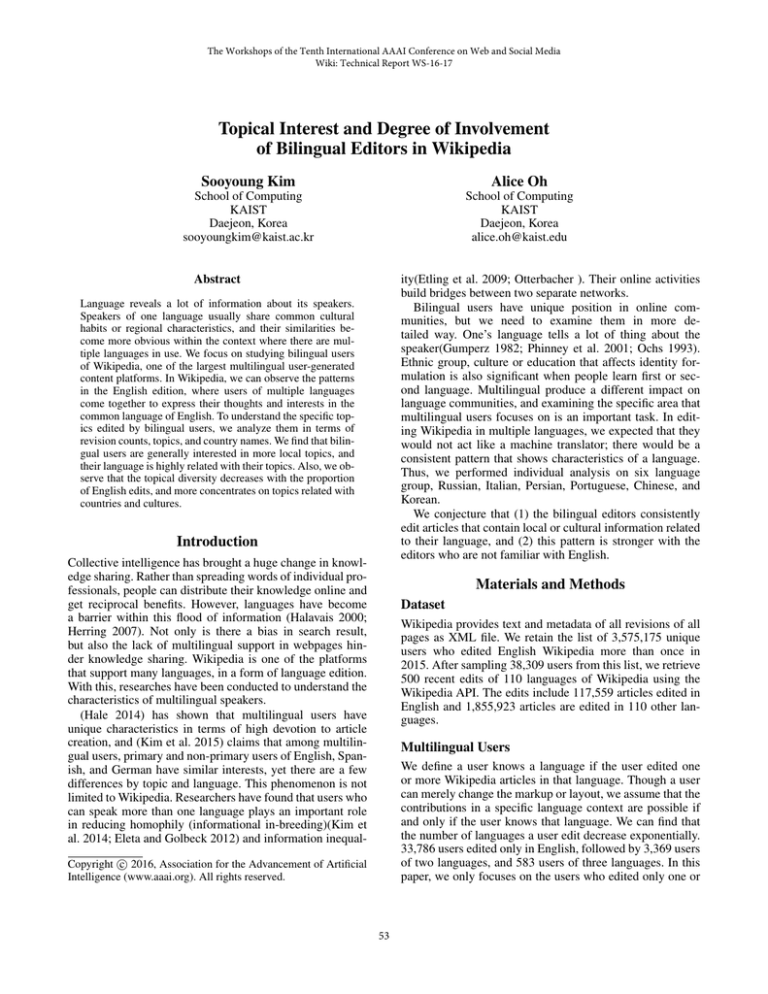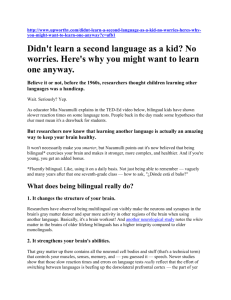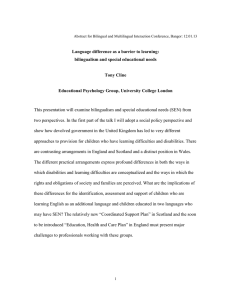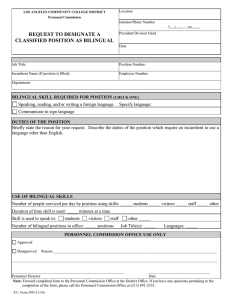Topical Interest and Degree of Involvement of Bilingual Editors in Wikipedia
advertisement

The Workshops of the Tenth International AAAI Conference on Web and Social Media Wiki: Technical Report WS-16-17 Topical Interest and Degree of Involvement of Bilingual Editors in Wikipedia Sooyoung Kim Alice Oh School of Computing KAIST Daejeon, Korea sooyoungkim@kaist.ac.kr School of Computing KAIST Daejeon, Korea alice.oh@kaist.edu ity(Etling et al. 2009; Otterbacher ). Their online activities build bridges between two separate networks. Bilingual users have unique position in online communities, but we need to examine them in more detailed way. One’s language tells a lot of thing about the speaker(Gumperz 1982; Phinney et al. 2001; Ochs 1993). Ethnic group, culture or education that affects identity formulation is also significant when people learn first or second language. Multilingual produce a different impact on language communities, and examining the specific area that multilingual users focuses on is an important task. In editing Wikipedia in multiple languages, we expected that they would not act like a machine translator; there would be a consistent pattern that shows characteristics of a language. Thus, we performed individual analysis on six language group, Russian, Italian, Persian, Portuguese, Chinese, and Korean. We conjecture that (1) the bilingual editors consistently edit articles that contain local or cultural information related to their language, and (2) this pattern is stronger with the editors who are not familiar with English. Abstract Language reveals a lot of information about its speakers. Speakers of one language usually share common cultural habits or regional characteristics, and their similarities become more obvious within the context where there are multiple languages in use. We focus on studying bilingual users of Wikipedia, one of the largest multilingual user-generated content platforms. In Wikipedia, we can observe the patterns in the English edition, where users of multiple languages come together to express their thoughts and interests in the common language of English. To understand the specific topics edited by bilingual users, we analyze them in terms of revision counts, topics, and country names. We find that bilingual users are generally interested in more local topics, and their language is highly related with their topics. Also, we observe that the topical diversity decreases with the proportion of English edits, and more concentrates on topics related with countries and cultures. Introduction Collective intelligence has brought a huge change in knowledge sharing. Rather than spreading words of individual professionals, people can distribute their knowledge online and get reciprocal benefits. However, languages have become a barrier within this flood of information (Halavais 2000; Herring 2007). Not only is there a bias in search result, but also the lack of multilingual support in webpages hinder knowledge sharing. Wikipedia is one of the platforms that support many languages, in a form of language edition. With this, researches have been conducted to understand the characteristics of multilingual speakers. (Hale 2014) has shown that multilingual users have unique characteristics in terms of high devotion to article creation, and (Kim et al. 2015) claims that among multilingual users, primary and non-primary users of English, Spanish, and German have similar interests, yet there are a few differences by topic and language. This phenomenon is not limited to Wikipedia. Researchers have found that users who can speak more than one language plays an important role in reducing homophily (informational in-breeding)(Kim et al. 2014; Eleta and Golbeck 2012) and information inequal- Materials and Methods Dataset Wikipedia provides text and metadata of all revisions of all pages as XML file. We retain the list of 3,575,175 unique users who edited English Wikipedia more than once in 2015. After sampling 38,309 users from this list, we retrieve 500 recent edits of 110 languages of Wikipedia using the Wikipedia API. The edits include 117,559 articles edited in English and 1,855,923 articles are edited in 110 other languages. Multilingual Users We define a user knows a language if the user edited one or more Wikipedia articles in that language. Though a user can merely change the markup or layout, we assume that the contributions in a specific language context are possible if and only if the user knows that language. We can find that the number of languages a user edit decrease exponentially. 33,786 users edited only in English, followed by 3,369 users of two languages, and 583 users of three languages. In this paper, we only focuses on the users who edited only one or c 2016, Association for the Advancement of Artificial Copyright Intelligence (www.aaai.org). All rights reserved. 53 CI CR US non-US Total 0.813 0.146 0.0452 0.102 Monolingual 0.815 0.145 0.0483 0.097 Bilingual 0.809 0.151 0.0338 0.117 Table 1: The difference in proportion of bilingual and monolingual users. (CI: Country-independent topics, CR: Country-related topics, US: topics related to the United States, non-US: topics related to countries other than the US.) all users. Thus, we also divide the U.S. topics and topics related to countries other that the U.S.. Figure 1: Log-log plot of the number of unique articles one user edited. Two user groups shows a linear relationship between the number of user and the number of articles, but multilingual users tend to edit more than monolingual users. Results Overall Activities We compare the number of articles edited by monolingual and multilingual users. The average of monolingual users is 4.20; whereas the average of bilingual users is 22.91. Figure 1 shows the histogram of users by their number of edited articles. The log-log plot of histogram shows that multilingual users have overall tendency of editing more, which aligns with H. Scott (Hale 2014). We also observed difference in topical interest of monolingual and multilingual users. We measure this by comparing monolingual and multilingual users with the total topic distribution. As shown in Table 1, multilingual users show high involvement in country country-related topics and low involvement in general, country-independent topic group. Also, among country-related topics, U.S. topics are popular among monolingual users, while multilingual users edits more on other countries, such as Greece, Israel, or Japan. two languages, since most of multilingual users are bilingual in terms of their editing behavior and the primary language is ambiguous with trilingual and quad-lingual users. Topic Extraction Using Latent Dirichlet Allocation In order to observe the editing behaviors of Wikipedia users, we focus on the characteristics of articles a user edited. Since most users do not reveal information about themselves in their user page, the content of articles they actually made revisions tells much about a user. From the texts of articles edited by our user sample, we extract topics of Wikipedia articles using Latent Dirichlet Allocation. We set the number of topics to K = 50, and employ online variational inference algorithm to estimate parameters with maximum iteration count 200. Appendix shows the result from LDA. We use this result in order to examine the interest of Wikipedia editors. Users are represented as the articles they edited, so each topic vector is averaged to exhibit topical interest of a user. Per-Language Analysis Although we detect bilingual users in 42 languages, some languages show distinct patterns in large scale. As shown in Appendix, a set of country names appears in one topic, and they are either linguistically or culturally similar. We sample 6 different languages from those topics, and measure the relationship between the language and user behaviors. We first measure the involvement in each topic group. In Figure 2, the first two column shows that the degree of involvement in general topic group and country-related topic group is different. Persian, Portuguese, and Chinese users actively edit general topics, and less actively edit country-related topics. However, all 6 language groups show low involvement in U.S related topics, and high involvement in countries other than the US. Appendix shows the distribution of 50 topics. The low involvement in country-related topic is due to the high-involvement in a few topics, such as T16 about music and T21 about weather. According to the language they edit, users show a skewness in certain topics, which is not related to countries but more detailed topics. We also measured the user interest in each country. Topics from LDA usually show several country names, which do not provide a detailed interest in one country. We counted the number of country names Topic Groups Each topic represents the contents that users are interested in. However, not all topics are valid. There are topics that contain syntactic or meaningless words. Also, it is more convenient to cluster the topics into large groups in order to analyze the behavior of each user group. Observing most probable word cloud in each topic, we manually classify the topics into two groups: country-related topic group, and country-independent general topic group. Country-related topic group consists of 36 topics that contains more than one region name, and general countryindependent topics. Among the country-related topics, there are three topics related to the United States (T1, T11, and T25 in Appendix). Contrary to other country-related topics, such as Greece, Russia or Pakistan, these topics can be frequently edited by 54 q Italian Country Name canada spain austria ireland australia denmark china Persian Country Name iran egypt nigeria canada israel russia switzerland Russian Country Name russia jersey china india jordan canada japan (a) (b) Figure 2: The difference in proportion of each language groups. The proportion of each group is subtracted by proportion of total population. The degree of involvement in each topic group differ across language pairs. in each article, and normalized by the total number. Table shows top 7 country names mentioned in articled edited by each language group. The result shows that the language of a user and their interest in countries are correlated. For example, Korean bilinguals are most interested in Korea, and Persian bilinguals show high interest in Iran. Though bilingual users of English and Italian do not frequently edit about Italy, we can observe that their interest is quite related with their geographical location. Proportion 0.048 0.04 0.037 0.037 0.035 0.03 0.026 Proportion 0.042 0.019 0.007 0.003 0.003 0.002 0.002 Proportion 0.09 0.057 0.05 0.05 0.046 0.045 0.045 Korean Country Name korea japan kenya australia china afghanistan canada Portugese Country Name brazil canada japan australia china spain india China Country Name hong kong china mexico japan poland india australia Proportion 0.081 0.053 0.039 0.03 0.029 0.02 0.015 Proportion 0.084 0.065 0.049 0.043 0.036 0.031 0.026 Proportion 0.112 0.088 0.061 0.049 0.045 0.037 0.033 Table 2: The average mentions of country names based on user edits. Proportion means normalized number of appearance of one country name over all countries. Language Inclination English tend to edit more local topics related to countries except for the US. Also, according to their language, Wikipedia users exhibit different topical interest. To observe the topical diversity of users, we examine the variance of topic vector of each article a user edited. Figure 4 shows the variance of topics with respect to the proportion of English articles. One dot represents one user. The overall trend is going up as the proportion of English gets higher. This indicates that the users who are not familiar with English focus on editing specific articles, and it is usually related with countries and local information. Although there are a few bilingual speakers who are equally fluent in two languages(Grosjean 1989), most people would be inclined to one language. The same fact applies to Wikipedia editors. We found that the number of articles a user edited in two languages seldom weighs the same. Figure 3 shows the histogram of normalized English article numbers by bilingual users. The distribution is roughly bimodal, which peaks at 0.05 and 0.98, indicating that most users exhibit inclination toward one language. Based on this, we define the users in two categories: English primary user, who edits English more that 70% of their time; and English non-primary user, who edits less than 30%. We compare the average topic distribution and the topical diversity between them. Topic analysis on this pair shows a similar behavior to the monolingual and bilingual pair. Figure 2(b) shows that the distribution of primary and non-primary user in four topic groups. Non-primary users are show more clear interest toward country-related topics, and exceptionally indifferent in the U.S and their culture. This indicates that users who are not familiar with English are also uninterested in a Englishspeaking country. Topic analysis shows that those who infrequently use Conclusion and Future works Our preliminary findings suggest that bilingual editors of Wikipedia show high involvement in Wikipedia. We find repeatedly that the contents of bilingual users are related with local topics, and their language plays a big role in choosing their topics. Our results have important implications regarding the extent to which bilingual users transfer information about which topics. While there is no doubt that the user interest is diverse and sometimes very specific, we find that their language affects the majority of bilingual users. We further find that bilingual users show frequent and consis- 55 Figure 3: The number of users according to their relative contribution of English over total contributions. Bilingual users edit extreme large or small amount of English articles. (CI: Country-independent topics, CR: Country-related topics, US: topics related to the United States, non-US: topics related to countries other than the US.) Figure 4: Variance of topic proportions across articles of a user. Plot represent the relationship between user involvement in English and the topic variance. Gumperz, J. J. 1982. Language and social identity, volume 2. Cambridge University Press. Halavais, A. 2000. National borders on the world wide web. New Media & Society 2(1):7–28. Hale, S. A. 2014. Multilinguals and wikipedia editing. In Proceedings of the 2014 ACM conference on Web science, 99–108. ACM. Herring, S. C. 2007. A faceted classification scheme for computer-mediated discourse. Language@ internet 4(1):1– 37. Kim, S.; Weber, I.; Wei, L.; and Oh, A. 2014. Sociolinguistic analysis of twitter in multilingual societies. In Proceedings of the 25th ACM conference on Hypertext and social media, 243–248. ACM. Kim, S.; Park, S.; Hale, S. A.; Kim, S.; Byun, J.; and Oh, A. 2015. Understanding editing behaviors in multilingual wikipedia. arXiv preprint arXiv:1508.07266. Kittur, A., and Kraut, R. E. 2008. Harnessing the wisdom of crowds in wikipedia: quality through coordination. In Proceedings of the 2008 ACM conference on Computer supported cooperative work, 37–46. ACM. Ochs, E. 1993. Constructing social identity: A language socialization perspective. Research on language and Social Interaction 26(3):287–306. Otterbacher, J. Chapter 3 our news, their events: A comparison of archived current events on english and greek wikipedias. Phinney, J. S.; Romero, I.; Nava, M.; and Huang, D. 2001. The role of language, parents, and peers in ethnic identity among adolescents in immigrant families. Journal of youth and Adolescence 30(2):135–153. tent mentions about certain countries across Wikipedia editions. Also, we observe that users who are not familiar with English are more topically focused. These findings suggest that many of the users editing two language editions of Wikipedia may have a high level of motivation of spreading information about themselves. This aligns with the claim that a good proportion of multilingual Wikipedia users may be power users who contribute to Wikipedia heavily(Kittur and Kraut 2008). Meanwhile, the interest of users could be explored by analyzing the topics using other measures. Also, topic vectors of articles, averaged to represent the interest of users may be investigated independently. Not only the proposed ideas but also various research questions could be probed and we hope to work on the questions in the future works. Acknowledgement This work was supported by Institute for Information & Communications Technology Promotion (IITP) grant funded by the Korea government (MSIP) (No. 10041313, UX-oriented Mobile SW Platform) References Eleta, I., and Golbeck, J. 2012. Bridging languages in social networks: How multilingual users of twitter connect language communities? Proceedings of the American Society for Information Science and Technology 49(1). Etling, B.; Kelly, J.; Faris, R.; and Palfrey, J. 2009. Mapping the arabic blogosphere: Politics. Culture, and Dissent/Berkman Center Research Publication . Grosjean, F. 1989. Neurolinguists, beware! the bilingual is not two monolinguals in one person. Brain and language 36(1):3–15. 56 Appendix Top words in 50 topics(the last column), and the average topic proportions of each language group. Topic words in yellow means topics are related with countries except for the US, and the words in orange means topics are related with the US. The topic proportions are represented as a relative values to the total topic distribution (average proportion per group-total proportion). It is color-coded, and red is for high-values, yet blue is for low, negative numbers. 57




